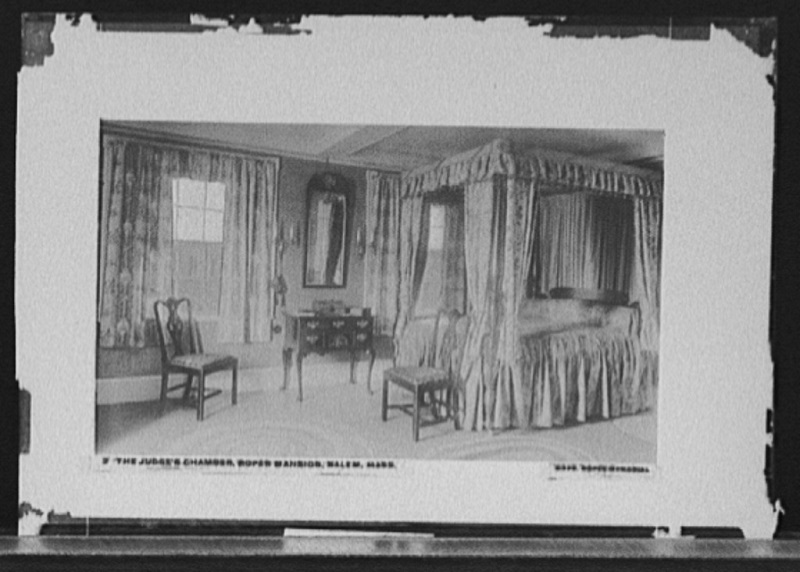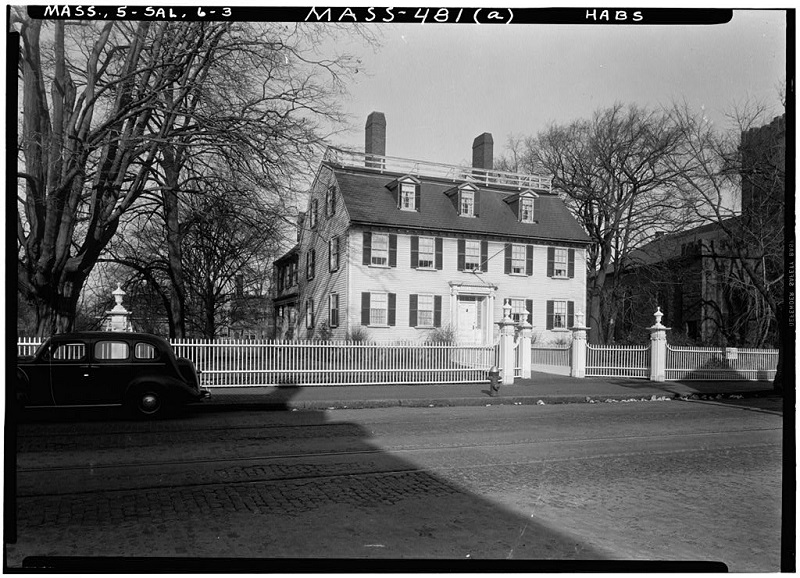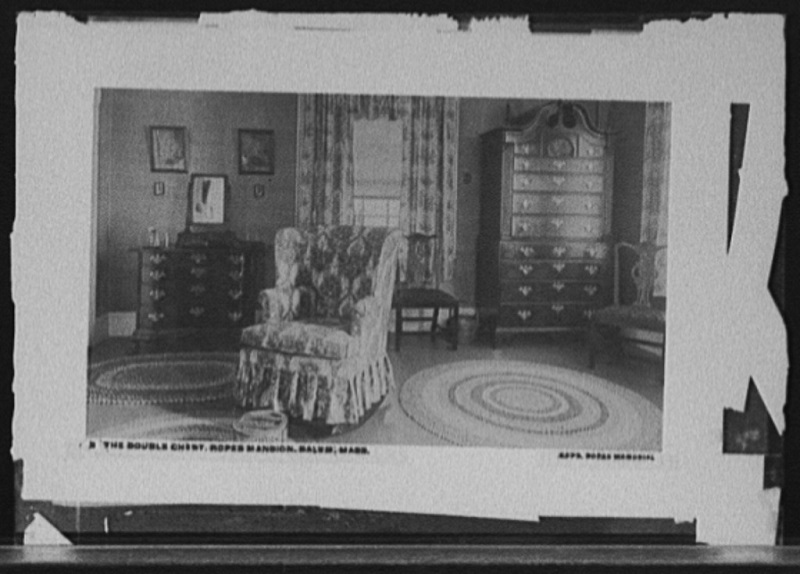Built around 1727, the Ropes Mansion is a historic Georgian-style mansion in Salem, Mass.
The house is a two and ½ story building with a wood clapboard exterior and a slate-shingled gamble roof and is located on a one acre plot of land on Essex Street.
The architect of the house is unknown but it was built for local merchant Samuel Barnard, a merchant who moved to Salem from Deerfield after the death of his wife and infant son in 1720.
Ropes remarried several times but never had any surviving heirs so the house passed down to his nephew, Joseph Barnard, and Joseph’s son, Ebenezer, who then sold it to Judge Nathaniel Ropes Jr in 1768.
In March of 1774, during the American Revolution, an angry mob attacked the house, throwing mud, sticks and rocks at the windows, while the crowd demanded that the loyalist Ropes renounce his allegiance to the British crown.
At the time of the attack, Ropes was sick in bed with smallpox and he died the following day. Many believed that the stress of the mob was a contributing factor in his death.
Ropes’ widow, Priscilla, moved her and their six children to Danvers but their oldest son, Nathaniel Ropes III, returned to the house with his wife Sarah after the war ended and began his merchant business in Salem.
Nathaniel and Sarah Ropes raised three children in the house, Nathaniel Ropes IV, Sarah (Sally) and Abigail.
Nathaniel Ropes IV later moved to Cincinnati, Ohio but his sisters Sally and Abigail continued living in the mansion into adulthood.
In 1807, the interior of the house was extensively renovated.
Sally Ropes went on to marry a merchant named Joseph Orne and gave birth to their daughter, Elizabeth, in the mansion in 1818 but Joseph died of tuberculosis that same year at the age of 22.
In the mid 1830s, the house was renovated again when five interior rooms and the central hall were remodeled and the central entrance at the front of the house was replaced with a Federal-style entrance that featured fluted Ionic columns, granite steps and a six-panel door.
In 1839, a tragic event occurred at the mansion when Sally’s sister, Abigail, was standing too close to the fire and her dress caught fire and she died three weeks later of the burns she sustained in the accident.
A few years later, in 1842, Elizabeth Ropes Orne died of tuberculosis in the upstairs bedroom at the age of 24.
Sally continued living in the house for many years until her own death in 1876. After her death, her nephew Nathaniel Ropes V moved from Cincinnati, Ohio to live in the mansion.
Additions to the house were constructed in 1881 and 1884. After Nathaniel Ropes V died in the house in 1893, it then passed to his sisters, Sarah, Mary and Eliza.
In 1894, the sisters moved the house back 30 feet from the street, under the supervision of architects architects Stone, Carpenter and Willson, and had central heat, plumbing and electricity installed.

In addition, a two and ½ story kitchen and service ell were also constructed at the back of the house and the wood spindle front fence was erected around the property.
During the renovations, a fire broke out in the house and heavily damaged it. It is not known who caused the fire but it was believed to be intentionally set, possibly by a disgruntled employee.
The house stayed in the Ropes family until the last Ropes sister, Eliza, died in 1907 and the house was left to the Trustees of the Ropes Memorial with a plan to establish a free botany school there as a memorial to the Ropes family.
The Trustees of the Ropes Memorial opened the house to the public as a historic house museum in 1912.
Also in 1912, a formal Colonial-style garden designed by Salem botanist and horticulturist John Robinson was established behind the house, which features features small, winding paths of brick and stone that lead to a center area. A wood and glass greenhouse was erected in the garden in 1916 and a shaded pond was added to the garden in 1930.
In 1981, the City of Salem established the McIntire Historic District, which includes Broad Street, Chestnut Street, Federal Street and Essex Street, where the Ropes Mansion is located.
In 1989, the Trustees of the Ropes Memorial donated the building to the Essex Institute, which later became the Peabody Essex Museum after a merger between the Peabody Museum of Salem and the Essex Institute in 1992.
In 1993, the house was featured in a scene in the Disney film Hocus Pocus.
On August 18, 2009, a fire broke out in the attic and damaged the attic and roof. The fire was believed to have been caused by a painter’s heat gun that was being used to remove old paint from the house’s exterior.
Although the painters quickly put the fire out with a fire extinguisher, the fire spread inside the walls and destroyed much of the third floor and attic and also caused water and smoke damage to the first and second floors.
As a result of the fire, the building closed to the public and underwent renovations and conservation work and finally reopened in 2015.
The house is currently furnished with 19th century furniture, such as a piano from 1893 and a Magee Grand stove from 1894, and features one of the largest surviving collection of Chinese export porcelain in the country as well as local artifacts, such as a 1865 wooden cup from the Salem Witch House and a 1890 silver spoon engraved with a witch.
The house is open to the public for self-guided tours every weekend from summer to fall and the garden is open to the public every day.
The mansion is now a stop on the Salem Heritage Trail, which is a walking trail connecting numerous historic sites in Salem.
Sources:
Messer, Nellie S. “A Colonial Homestead for Posterity.” Country Life in America, Vol. XIX, Doubleday, Page & Company, 1916
Tolles, Bryant Franklin and Carolyn K. Tolles. Architecture in Salem: An Illustrated Guide. University Press New England, 2004.
McGregor, Andrew. “Garden ropes in visitors.” Salem News, 20 Aug. 2008, salemnews.com/archives/garden-ropes-in-visitors/article_e7d94d6a-eaca-5ee1-9d69-41181d0176e6.html
Matarazzo, Bruno. “Fire rips through Salem’s Ropes Mansion.” Salem News, 15 Aug. 2009, salemnews.com/archives/fire-rips-through-salems-ropes-mansion/article_60661749-94d0-5622-8633-d28f0cf05f4e.html
D’Agostino, Kristin. “Ropes fire prompts look at historical renovations.” Wicked Local, 10 Sept. 2009, wickedlocal.com/story/salem-gazette/2009/09/10/ropes-fire-prompts-look-at/38566951007/
“Old Structure Damaged.” Boston Globe, 22 March. 1894, newspapers.com/clip/29786562/ropes-mansion-fire/
Legault, William. “Hidden Gem: Ropes Mansion Garden.” Patch, 25 July. 2011, patch.com/massachusetts/salem/hidden-gem-ropes-mansion-garden
Radsken, Jill. “Velvet ropes are history with restoration of Salem mansion.” Boston Globe, 27 May. 2015, bostonglobe.com/lifestyle/style/2015/05/27/ropes-mansion-the-reimagining-museum/0zIsuTYqLMLvPlWNoaXLcL/story.html
Graves, Noelle. “Ropes Mansion Reopens.” Salem News, 21 May. 2015, salemnews.com/news/local_news/ropes-mansion-reopens/article_59684b97-ff27-5864-b838-036de66d6770.html
“Ropes Mansion, 1727.” Salem State, teh.salemstate.edu/educatorsguide/pages/innovation/RopesMansion.pdf
“The McIntire Historic District.” Salem.org, salem.org/listing/mcintire-district/
“Historic Building Detail: SAL. 1540 Ropes, Nathaniel House.” MACRIS.net, Massachusetts Cultural Resource Information System, Massachusetts Historical Commission, mhc-macris.net/#!/details?mhcid=SAL.1540






As a 28-yr. resident of MA between 1970 and 2007 – inc. 5 yrs. in Peabody and 1 in Lynn. I fondly recall my strolls along Essex St., always admiring the gorgeous Ropes Mansion. Too bad it wasn’t open to the public at that time, and well before the days of Internet, I was unaware of the fascinating history of the Ropes family. I was especially struck by the similar deaths of Nathaniel Rope’s sister Abigail by fire, and Henry W. Longfellow’s wife’s death by fire also (in their Cambridge home) both incidents occurring through their dresses catching fire due to close proximity to the fire, and through a lighted candle being swept onto Longfellow’s wife’s dress!! How very ironic this is. I wonder if numerous Colonial women died in this way! Alas, their dresses were too voluminous for their own good! How tragic!! Thank you for this most fascinating account especially to a long-time New Englander and MA resident my 1st adult home, and heart home all my life, even tho having lived out west for some time after leaving MA!!
Hi Elizabeth. I’m glad you enjoyed the article. Yes actually it was very common for colonial women to die that way. They wore long dresses and often had to stand close to an open fire to cook and to get warm in their drafty houses so their dresses often caught fire. It was very tragic.
I was born in Salem and lived there for 21 years until I was married.
Years ago I took a photo while at the Ropes Mansion in the gardens of three children wearing hats looking at the pond and it was published online in the Salem Evening News.
Having walked the brick sidewalks of Salem from my elementary school to the library and to the downtown
I often passed by this beautiful house.
I never knew until reading your article that the will/trust stipulated that a botanical school be on the property. Thank you for this well-written and informative article.